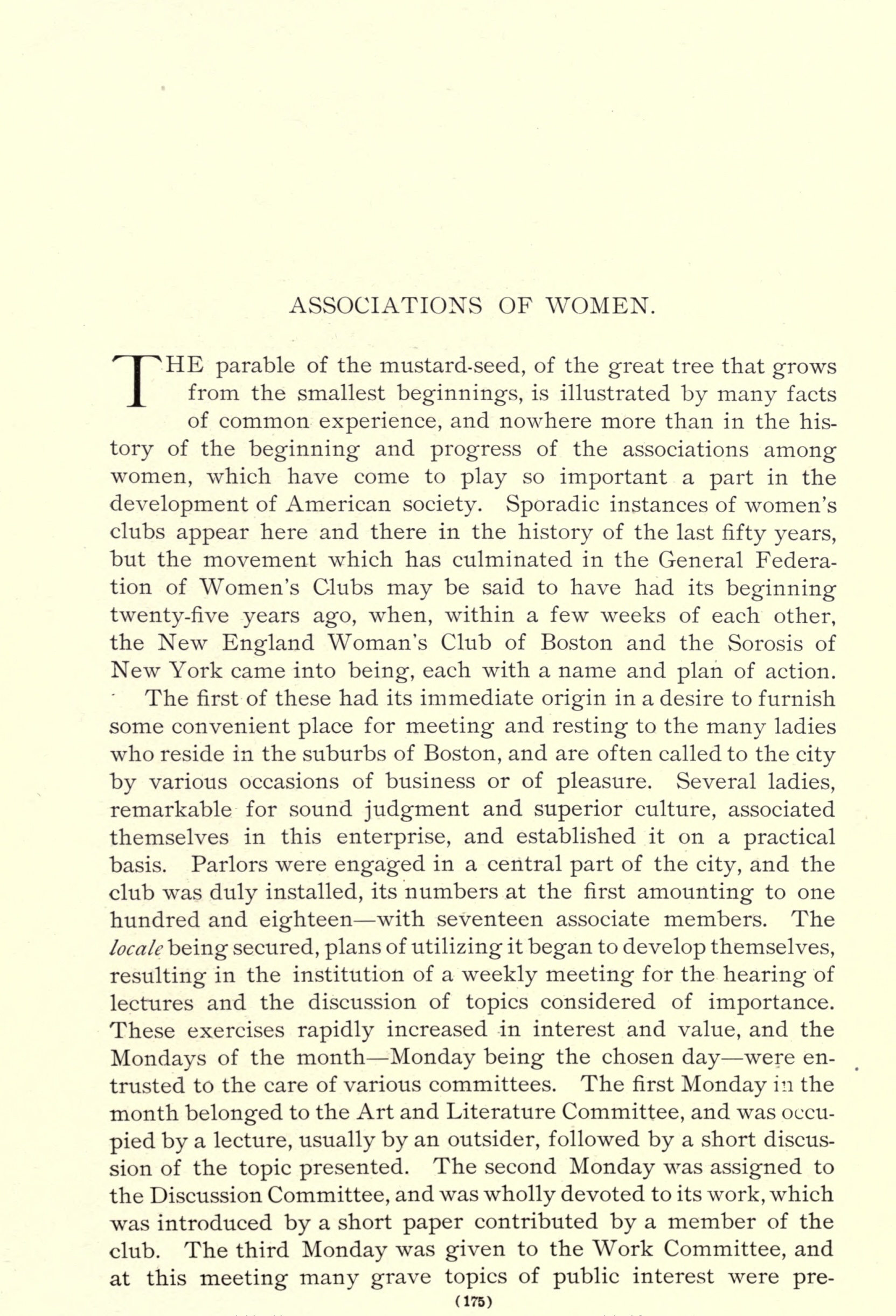
ASSOCIATIONS OF WOMEN.
THE parable of the mustard-seed, of the great tree that grows from the smallest beginnings, is illustrated by many facts of common experience, and nowhere more than in the history of the beginning and progress of the associations among women, which have come to play so important a part in the development of American society. Sporadic instances of women's clubs appear here and there in the history of the last fifty years, but the movement which has culminated in the General Federation of Women's Clubs may be said to have had its beginning twenty-five years ago, when, within a few weeks of each other, the New England Woman's Club of Boston and the Sorosis of New York came into being, each with a name and plan of action.
The first of these had its immediate origin in a desire to furnish some convenient place for meeting and resting to the many ladies who reside in the suburbs of Boston, and are often called to the city by various occasions of business or of pleasure. Several ladies, remarkable for sound judgment and superior culture, associated themselves in this enterprise, and established it on a practical basis. Parlors were engaged in a central part of the city, and the club was duly installed, its numbers at the first amounting to one hundred and eighteen—with seventeen associate members. The locale being secured, plans of utilizing it began to develop themselves, resulting in the institution of a weekly meeting for the hearing of lectures and the discussion of topics considered of importance. These exercises rapidly increased in interest and value, and the Mondays of the month—Monday being the chosen day—were entrusted to the care of various committees. The first Monday in the month belonged to the Art and Literature Committee, and was occupied by a lecture, usually by an outsider, followed by a short discussion of the topic presented. The second Monday was assigned to the Discussion Committee, and was wholly devoted to its work, which was introduced by a short paper contributed by a member of the club. The third Monday was given to the Work Committee, and at this meeting many grave topics of public interest were pre-

TAPESTRY FROM RAPHAEL'S CARTOON, "THE MIRACULOUS DRAUGHT OF
FISHES."
ANNIE LYMAN.
UNITED STATES.
sented, often by experts, and commented upon. The fourth Monday, at first reserved for some popular entertainment, was at last given in charge to the Committee on Education. To these occasions was soon added a Club Tea, following the discussion of the Work Committee afternoon.
The club embraced in its membership a number of able women, and the zeal of the more thoughtful soon made itself felt throughout the whole body. Questions very important to the community, and reforms which have proved very valuable, were sometimes started at these meetings, and have been much forwarded by the action of the club. While remaining distinctively a woman's club, a few eminent men were admitted to its fellowship. Prominent among these were William Lloyd Garrison, Ralph Waldo Emerson, the poet Whittier, and noble Judge Sewall, the untiring champion of the political and civil rights of women. Miss Abby W. May, a woman eminent in the community for judgment and character, was the life-long chairman of the Work Committee. Mrs. Caroline M.

MINIATURE.
CAMILLE ISBERT.
FRANCE.
Severance was the first president of the club. The writer of this paper succeeded her, and has remained in that office ever since. The secretary from the start has been Miss Lucia M. Peabody, well known in her earlier life as one of the ablest educators in New England. The club, whose membership has extended to 230, has for years past occupied pleasant parlors on Park Street, a region once consecrated to highest fashion.
The methods of the New York Sorosis were somewhat different from those just described. This club chose for its place of meeting a large and convenient parlor in Delmonico's well-known restaurant, where luncheon was usually served to them. Their meetings were once a fortnight, and while sometimes devoted to the gravest questions, were often enlivened by music and recitations. The
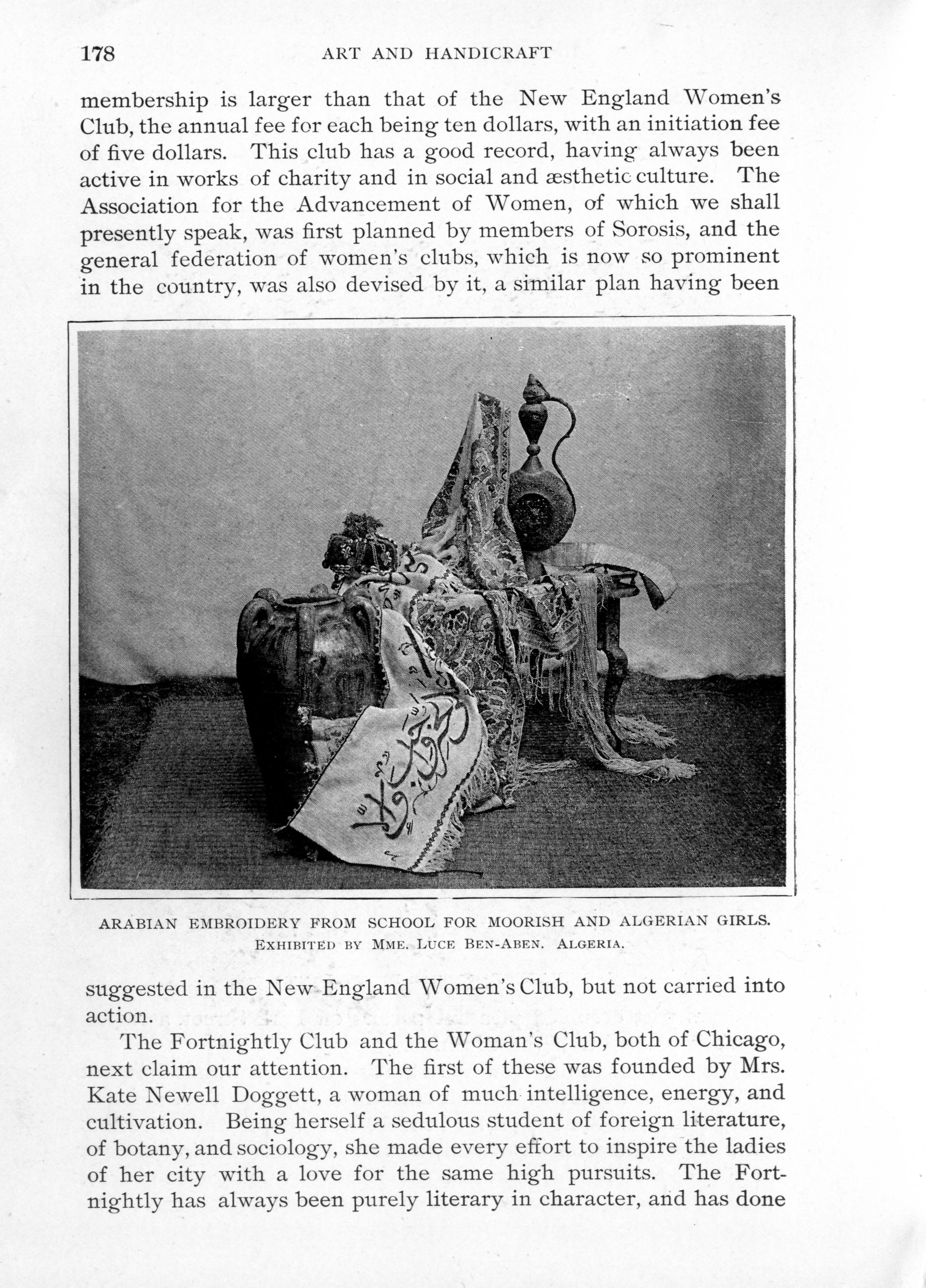
ARABIAN EMBROIDERY FROM SCHOOL FOR MOORISH AND ALGERIAN GIRLS.
EXHIBITED BY MME. LUCE. BEN-ABEN.
ALGERIA.
membership is larger than that of the New England Women's Club, the annual fee for each being ten dollars, with an initiation fee of five dollars. This club has a good record, having always been active in works of charity and in social and æsthetic culture. The Association for the Advancement of Women, of which we shall presently speak, was first planned by members of Sorosis, and the general federation of women's clubs, which is now so prominent in the country, was also devised by it, a similar plan having been suggested in the New England Women's Club, but not carried into action.
The Fortnightly Club and the Woman's Club, both of Chicago, next claim our attention. The first of these was founded by Mrs. Kate Newell Doggett, a woman of much intelligence, energy, and cultivation. Being herself a sedulous student of foreign literature, of botany, and sociology, she made every effort to inspire the ladies of her city with a love for the same high pursuits. The Fortnightly has always been purely literary in character, and has done
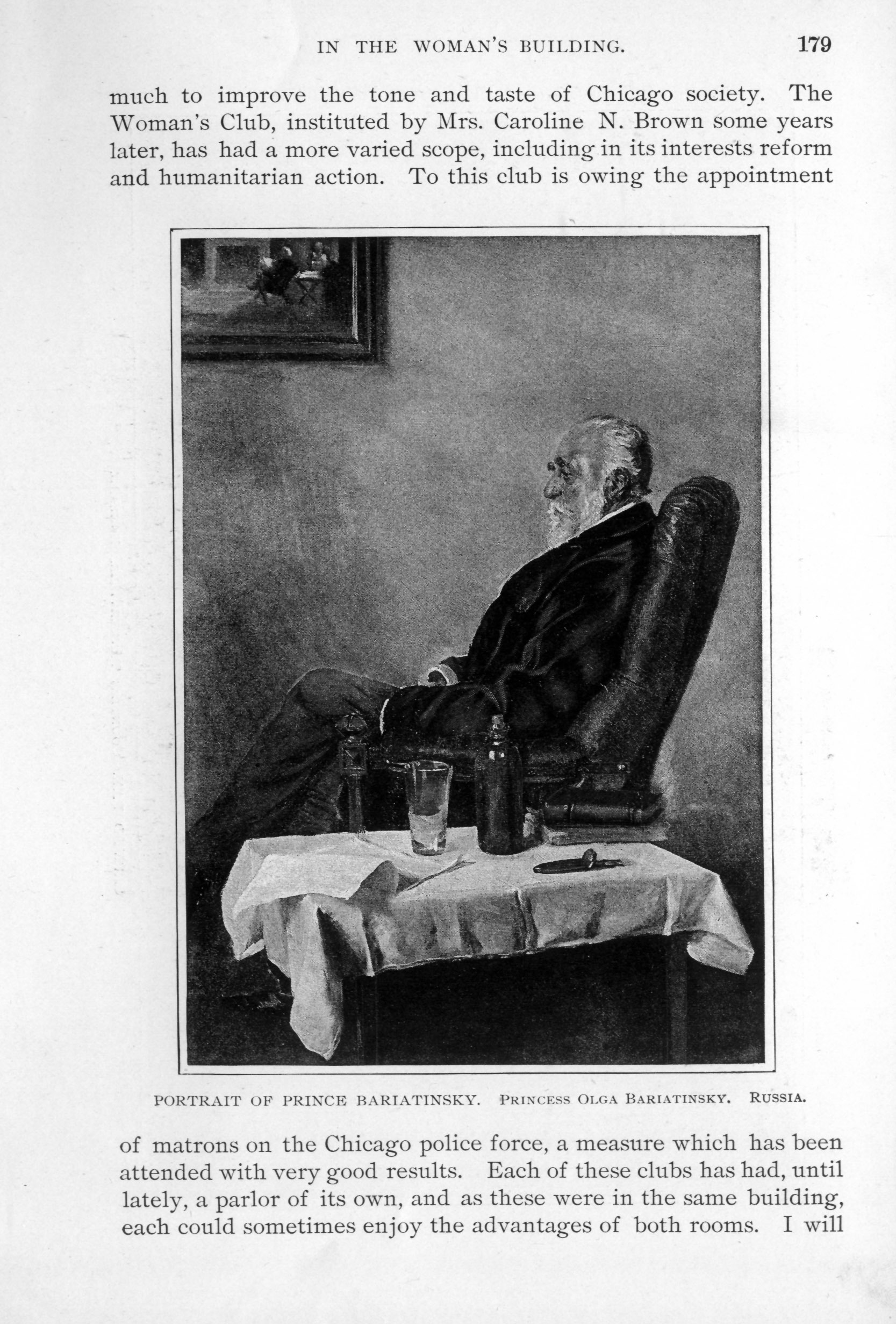
PORTRAIT OF PRINCE BARIATINSKY.
PRINCESS OLGA BARIATINSKY.
RUSSIA.
much to improve the tone and taste of Chicago society. The Woman's Club, instituted by Mrs. Caroline N. Brown some years later, has had a more varied scope, including in its interests reform and humanitarian action. To this club is owing the appointment of matrons on the Chicago police force, a measure which has been attended with very good results. Each of these clubs has had, until lately, a parlor of its own, and as these were in the same building, each could sometimes enjoy the advantages of both rooms. I will
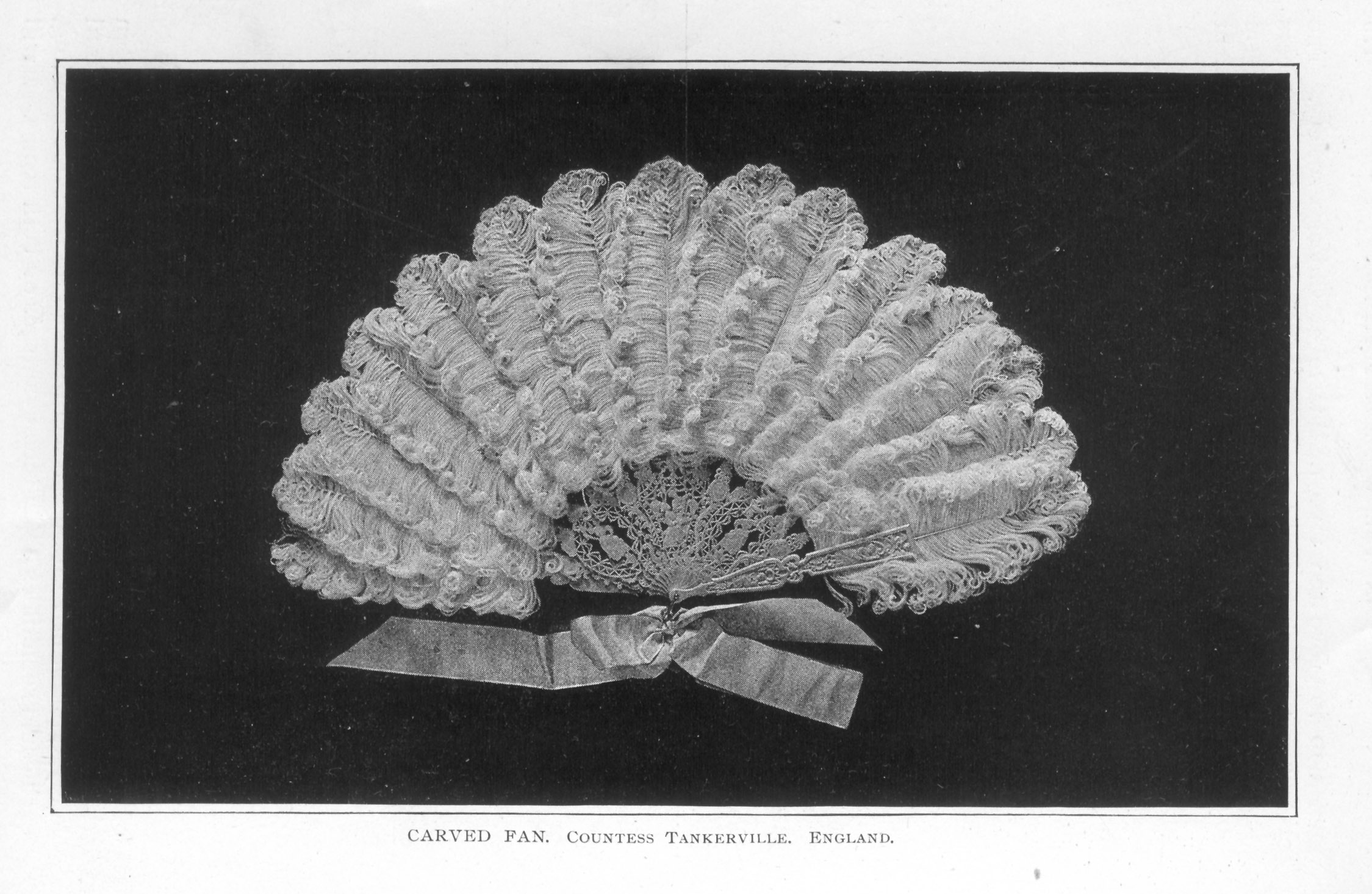
CARVED FAN.
COUNTESS TANKERVILLE.
ENGLAND.

only further say that both clubs are now in active and successful operation.
The Association for the Advancement of Women, familiarly spoken of as the A. A. W., was instituted by the New York Sorosis in 1873. Mrs. Jenny June Croly had, at an earlier period, issued a call for a congress of women, which resulted in the holding of a parliamentary conference in the city of New York. No organization, however, resulted from this. At the date given above a call was issued to women of many pursuits and occupations, some of them already known by reputation. This was signed by the president of Sorosis, and other officers. The first congress was held in New York, and was largely attended. Mrs. Livermore was its president; Mrs. Charlotte B. Wilbour, then president of Sorosis, was chairman of the executive committee. The meetings lasted for three days, and the papers and discussions received very favorable notice in the public prints. Conspicuous among those who attended it were Mrs. Elizabeth Cady Stanton, Mrs. Isabella Beecher Hooker, Mrs. Sara Spencer of Washington, D. C., Antoinette Brown Blackwell, and Maria Mitchell, professor of astronomy at Vassar college, and the writer. Miss Alice C. Fletcher, now so well known as a student of ethnology and as a friend to the Indians, was the efficient and valued secretary of the association. This congress resulted in the formation of a permanent association, whose office it became to hold a yearly congress in various important cities of the Union, with a special view to the instruction of their own sex and the formation of women's clubs, many of which resulted from its influence. The plan of the Association was rather vague at first, but the labor bestowed upon it resulted in the formation of various committees, among which its work was divided. Its second president was Maria Mitchell, who served in that capacity with great acceptance for two years. She was succeeded by Mrs. Doggett of Chicago, who in turn was followed by Mrs. Julia Ward Howe, who still remains president of the association. The congresses have been held in Boston, Providence, Portland (Me.), Syracuse, Buffalo, Grand Rapids, Denver, Toronto, Baltimore, Cleveland, Louisville, Memphis, and other cities, and in all of these places have awakened great interest and have stimulated association among women.
The two parent clubs, the Sorosis and the New England Women's Club, were soon consulted by various bodies of women desiring to form similar associations. To these all possible help and encouragement was given by the New England Club, and, presum-

ably, by its sister Sorosis, and far and wide throughout the land the club movement grew and the circles multiplied. These bodies were very various in their plans and pursuits, but all were determined to do good work, and their record has been such as to win a place in the public esteem for what was at first considered a dangerous and man-aping innovation. The word club, indeed, is susceptible of more than one interpretation, and to many, no doubt, may have at first suggested the thought of careless manners and of idle conversation. At one of the recent woman's congresses a speaker playfully asked whether men at their clubs occupied themselves in discussing the proper ordering of their households, the education of their children, and kindred subjects. The question called forth some laughter from the audience, who were well aware that, while these topics receive much attention in women's clubs, they are not prominently brought forward in those frequented by men.
An important era in club history was marked by the institution of a general federation of women's clubs, which, like the A. A. W., was first called for by the New York Sorosis, and has now become an important factor in the community. The first president of the federation was Mrs. Charlotte Emerson Brown of Orange, N. J. This lady proved eminently qualified for the position to which she was called, having devoted much time and labor to the affairs of the federation, and having shown in her work a truly catholic and disinterested spirit. At the close of her first term of office she was reëlected with almost entire unanimity. She reports the number of clubs in the federation as over three hundred. The conventions of this body are biennial, the first having been held in New York and the second in Chicago.
This general union is likely to be supplemented by State federations, which may hold State conventions. This plan is not yet perfected.
The associations for study, and those devoted to benevolent action connected with churches of all denominations, can not be here enumerated. Among them, however, we may mention as being of especial interest, the Zenana Missions in India, instituted and supported by these associations. The Society for the Encouragement of Studies at Home, although in no sense a club, should yet be mentioned with honor among the associations of women. Its work is done by correspondence, and its years already number twenty. The following quotation from an authorized statement gives us in brief some of its features:

SILK AND GOLD EMBROIDERED PANEL.
WORKING WOMAN'S SOCIETY OF VIENNA. AUSTRIA.
"In all, more than six thousand women appear on the rolls, geographically distributed over forty-three States, one Territory, and Canada.
"The methods include regular correspondence, memory notes, monthly reports of work done, frequent examinations on books or subjects—answered on honor—arranged to help the student to order and make truly hers the newly acquired knowledge; and abstracts of books, or papers on special points, required according to the ability of the student.
"In the seventeen years of the society's life nearly all grades of social position have been represented by our students—women of leisure, many of whom soon became helpers in the work; teachers, including a colored one in the South; graduates of col-
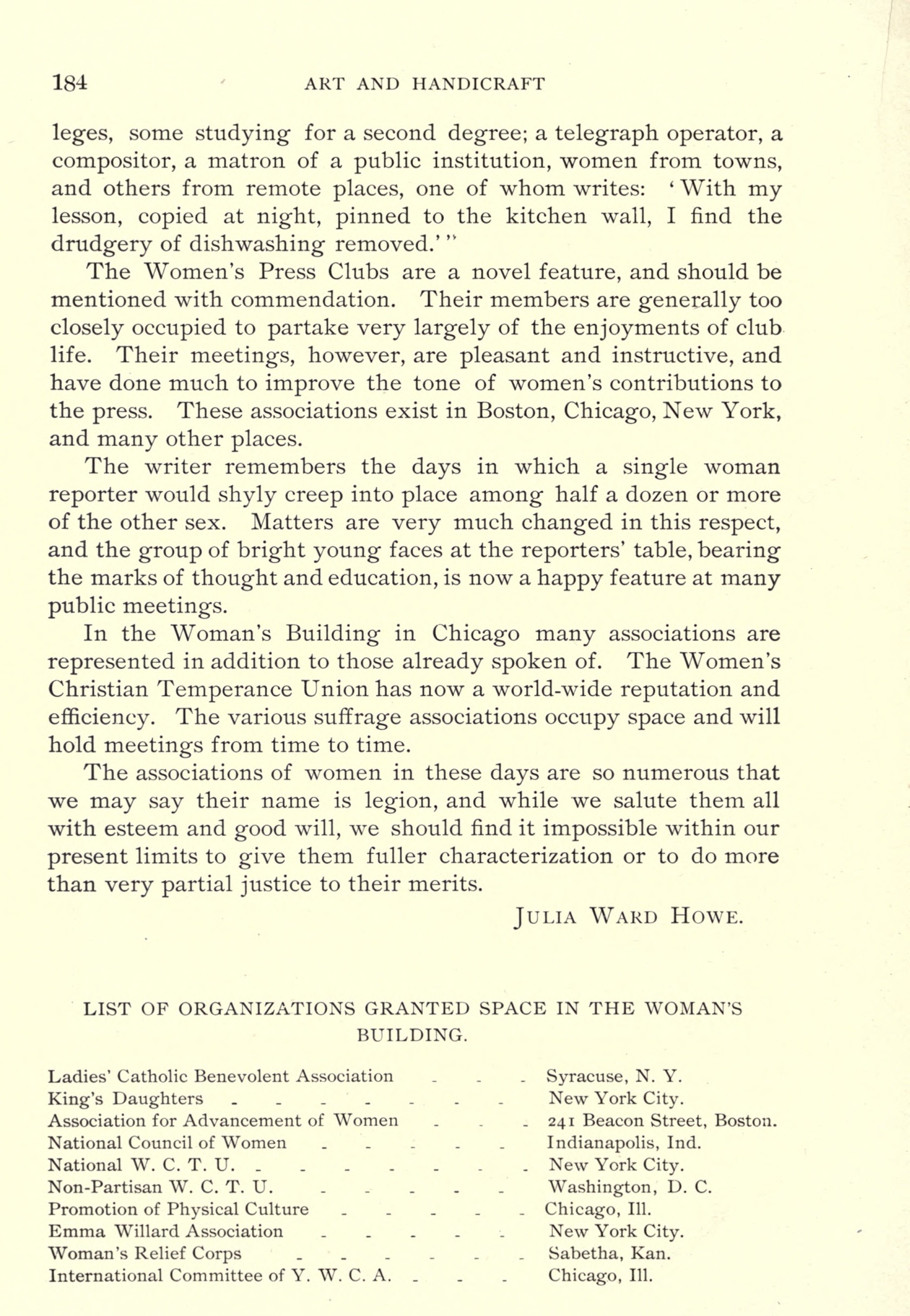
leges, some studying for a second degree; a telegraph operator, a compositor, a matron of a public institution, women from towns, and others from remote places, one of whom writes: 'With my lesson, copied at night, pinned to the kitchen wall, I find the drudgery of dishwashing removed.'"
The Women's Press Clubs are a novel feature, and should be mentioned with commendation. Their members are generally too closely occupied to partake very largely of the enjoyments of club life. Their meetings, however, are pleasant and instructive, and have done much to improve the tone of women's contributions to the press. These associations exist in Boston, Chicago, New York, and many other places.
The writer remembers the days in which a single woman reporter would shyly creep into place among half a dozen or more of the other sex. Matters are very much changed in this respect, and the group of bright young faces at the reporters' table, bearing the marks of thought and education, is now a happy feature at many public meetings.
In the Woman's Building in Chicago many associations are represented in addition to those already spoken of. The Women's Christian Temperance Union has now a world-wide reputation and efficiency. The various suffrage associations occupy space and will hold meetings from time to time.
The associations of women in these days are so numerous that we may say their name is legion, and while we salute them all with esteem and good will, we should find it impossible within our present limits to give them fuller characterization or to do more than very partial justice to their merits.
JULIA WARD HOWE.
LIST OF ORGANIZATIONS GRANTED SPACE IN THE WOMAN'S BUILDING.
| Ladies' Catholic Benevolent Association | Syracuse, N. Y. |
| King's Daughters | New York City. |
| Association for Advancement of Women | 241 Beacon Street, Boston. |
| National Council of Women | Indianapolis, Ind. |
| National W. C. T. U. | New York City. |
| Non-Partisan W. C. T. U. | Washington, D. C. |
| Promotion of Physical Culture | Chicago, Ill. |
| Emma Willard Association | New York City. |
| Woman's Relief Corps | Sabetha, Kan. |
| International Committee of Y. W. C. A. | Chicago, Ill. |
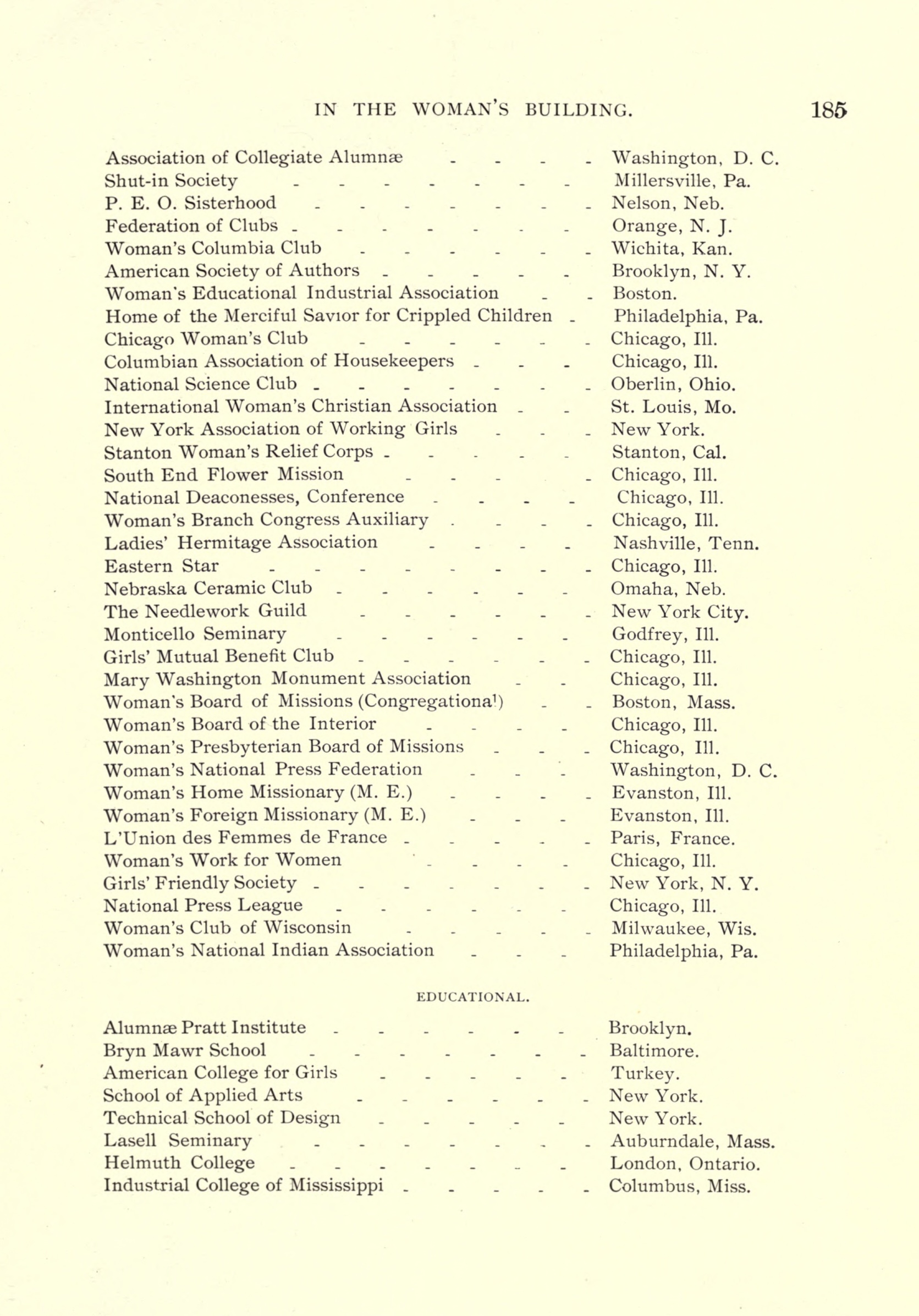
| Association of Collegiate Alumnæ | Washington, D. C. |
| Shut-in Society | Millersville, Pa. |
| P. E. O. Sisterhood | Nelson, Neb. |
| Federation of Clubs | Orange, N. J. |
| Woman's Columbia Club | Wichita, Kan. |
| American Society of Authors | Brooklyn, N. Y. |
| Woman s Educational Industrial Association | Boston. |
| Home of the Merciful Savior for Crippled Children | Philadelphia, Pa. |
| Chicago Woman's Club | Chicago, Ill. |
| Columbian Association of Housekeepers | Chicago, Ill. |
| National Science Club | Oberlin, Ohio. |
| International Woman's Christian Association | St. Louis, Mo. |
| New York Association of Working Girls | New York. |
| Stanton Woman's Relief Corps | Stanton, Cal. |
| South End Flower Mission | Chicago, Ill. |
| National Deaconesses, Conference | Chicago, Ill. |
| Woman's Branch Congress Auxiliary | Chicago, Ill. |
| Ladies' Hermitage Association | Nashville, Tenn. |
| Eastern Star | Chicago, Ill. |
| Nebraska Ceramic Club | Omaha, Neb. |
| The Needlework Guild | New York City. |
| Monticello Seminary | Godfrey, Ill. |
| Girls' Mutual Benefit Club | Chicago, Ill. |
| Mary Washington Monument Association | Chicago, Ill. |
| Woman's Board of Missions (Congregational) | Boston, Mass. |
| Woman's Board of the Interior | Chicago, Ill. |
| Woman's Presbyterian Board of Missions | Chicago, Ill. |
| Woman's National Press Federation | Washington, D. C. |
| Woman's Home Missionary (M. E.) | Evanston, Ill. |
| Woman's Foreign Missionary (M. E ) | Evanston, Ill. |
| L'Union des Femmes de France | Paris, France. |
| Woman's Work for Women | Chicago, Ill. |
| Girls' Friendly Society | New York, N. Y. |
| National Press League | Chicago, Ill. |
| Woman's Club of Wisconsin | Milwaukee, Wis. |
| Woman's National Indian Association | Philadelphia, Pa. |
EDUCATIONAL.
| Alumnæ Pratt Institute | Brooklyn. |
| Bryn Mawr School | Baltimore. |
| American College for Girls | Turkey. |
| School of Applied Arts | New York. |
| Technical School of Design | New York. |
| Lasell Seminary | Auburndale, Mass. |
| Helmuth College | London, Ontario. |
| Industrial College of Mississippi | Columbus, Miss. |

Engraved by Rand, McNally & Co.
THE CONVENT OF SANTA MARIA DE LA RABIDA.
THE KRUPP, DAIRY, AND FORESTRY BUILDINGS BEYOND.
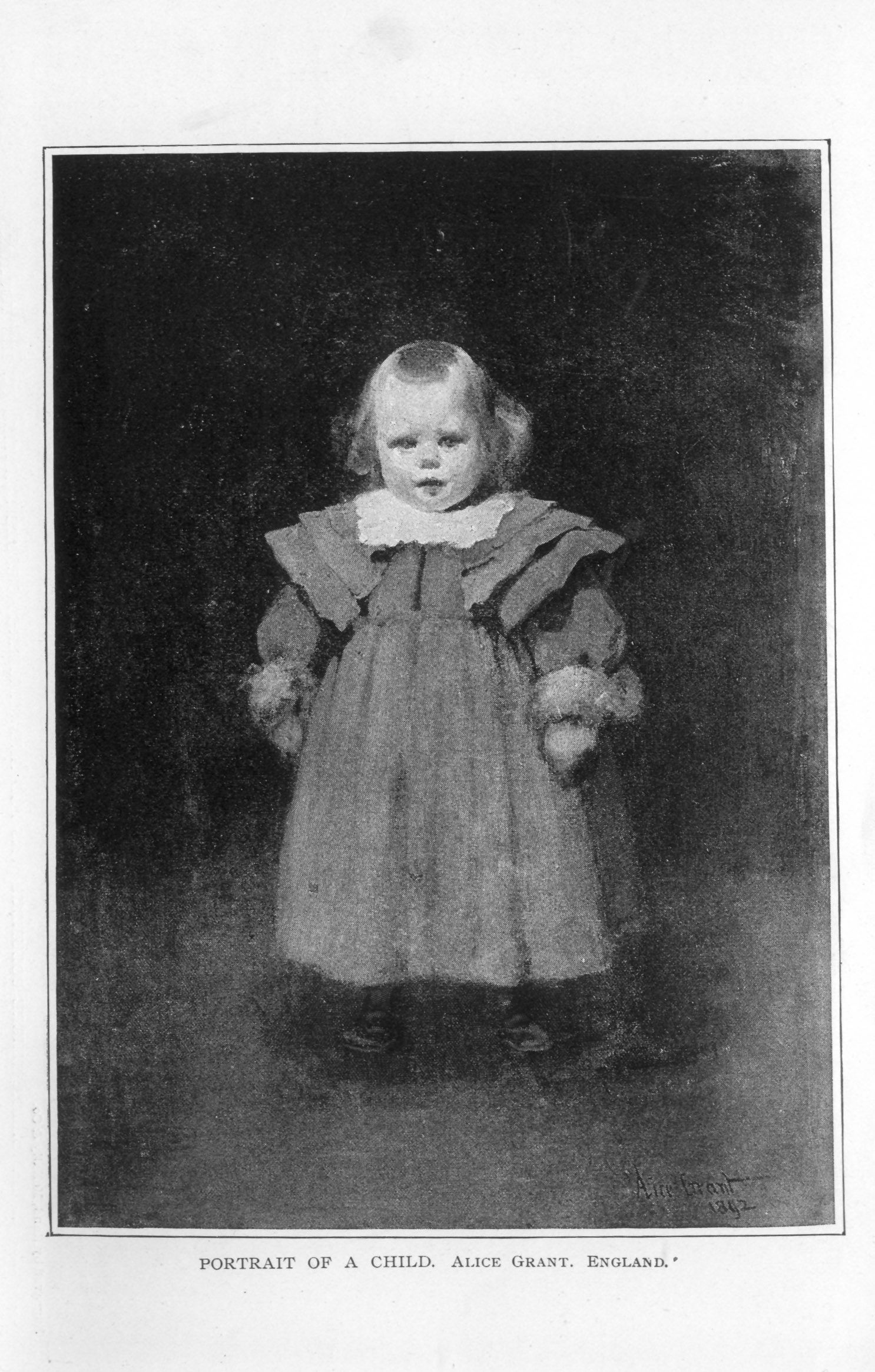
PORTRAIT OF A CHILD.
ALICE GRANT.
ENGLAND.
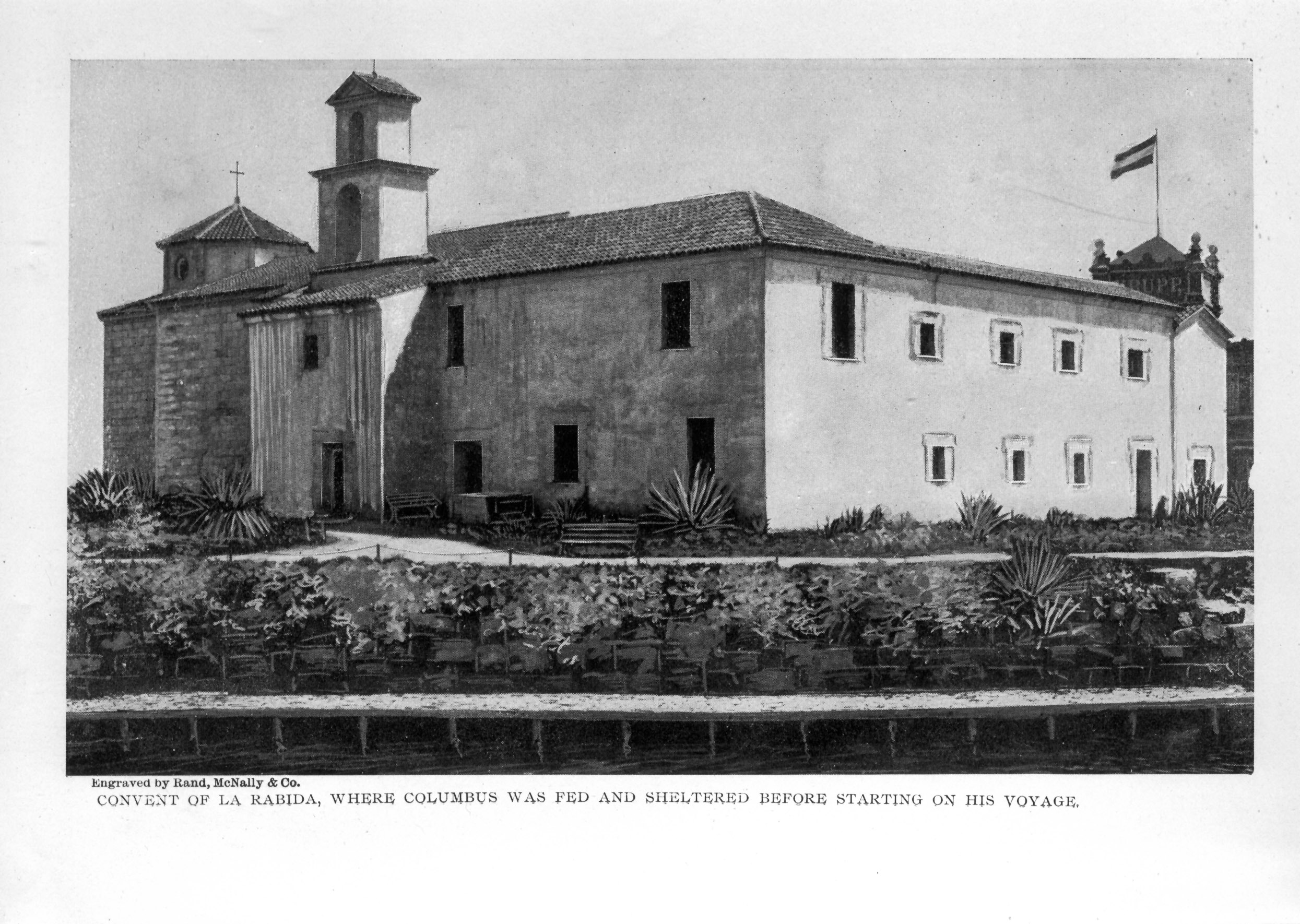
Engraved by Rand, McNally & Co.
CONVENT OF LA RABIDA,
WHERE COLUMBUS WAS FED AND SHELTERED BEFORE STARTING ON HIS VOYAGE.